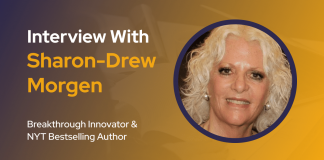Hi Salman, tell us about yourself and your background?
Hi Alon, thanks for having me. I currently work for Forrester based in London, working with large organizations worldwide across industries and customer experience maturity levels to set up and accelerate their CX initiatives to ultimately achieve successful, measurable outcomes. It’s a great position to be in, as I get the chance to work with senior business leaders and help them shape their companies’ future. I run the CX Council product in EMEA, and our ultimate aim is to increase the customer-centricity of the organizations we work with. I’ve always been fascinated by how companies engage with customers and how firms can sometimes get the experience so wrong (and of course very often, so right, too), so it’s a pleasure and honestly a privilege to get an in-depth look into so many different types of CX programs and to help them to improve.
How can brands better utilize consumer reviews
Online commerce was booming in 2020, and so did consumer reviews – How can brands better utilize this data to improve their customers’ experience?
Customer reviews are an interesting concept, especially as there are fewer opportunities for customers to physically see and touch products in person before buying these days. Overall I believe they are a positive thing to have both for customers and companies, as without them, there would be limited opportunity for feedback just on the product itself. Although reviews are often polarized with extremely positive or negative comments, and that you do have to question the trust element from time to time, brands can use this data in several ways:
- To see who uses their products – the buyer and the user are very often two different people. Reviews give firms a chance to see with whom their products are proving popular.
- To see how customers are using specific products in practice may sometimes be different from the way the firm initially intended.
- To uncover potential additional opportunities for revenue – e.g., if certain product colorways or designs are proving popular, firms can expand their future portfolio accordingly.
- To let customers know that firms have listened to their feedback and will act to fix problems.
- To gather unsolicited feedback about specific parts of a product or service experience:
- Those who take the time to review a product or service usually do so because they care about the experience they have received. Some reviewers go into considerable amounts of depth, often about smaller yet still very significant aspects of the experience. This insight can prove valuable for firms as it can uncover feedback about aspects of the experience that they may not have covered previously.
In your POV – What is the ultimate checklist for a good customer experience strategy?
A CX strategy should work to include several different components. Some of them are often overlooked and are actually a key factor in communicating to the wider organization what the CX team’s intentions are and what collaborators can expect from them. Fundamental elements of a CX strategy should be
- What the intended experience is – develop a vision and clearly articulate the target customer
- How the organization will achieve it – which resources will be leveraged and which initiatives will be prioritized.
- How will the organization know it has achieved its ambitions – KPIs and metrics.
The important thing here is that a CX Strategy should be tightly aligned to the organization’s commercial goals. Yes, there will be some natural divergence, but overall, the greater the alignment, the easier the strategy will be to sell in.
Here I would like to reference Forrester (2018) CX Strategy Essentials
How much has customer experience changed in the social distancing era – what role digital transformation has in this crisis?
The importance of customer experience has certainly come into the conversation a lot more. Consumer issues have obviously always been discussed, but there has been a bigger spotlight on how customers are treated during the pandemic. So firms now more than ever need to be super clear about what they promise and be committed to delivering on this promise. Outside of a firm’s employees, digital is clearly the biggest enabler of a successful customer experience delivery. eCommerce platforms and order management systems enable several new possibilities for established businesses that the pandemic has impacted. For example, restaurants that can adapt to provide a takeaway service can leverage local on-demand delivery platforms to reach a much broader audience than the immediate vicinity. This allows businesses who would otherwise be closed entirely to leverage vital lifelines and obviously allows customers to experience a broader range of experiences. Digital must be seen as a critical enabler and not the be-all/end-all of customer experience, especially during the pandemic.
What was the biggest lesson you learned in 2020?
The biggest lesson I learned is that the notion of the community (local, international, or even virtual) is still alive and well. The feelings may be different from the communities everyone experienced prior to the internet and social media. Still, I know that I’ve relied heavily on my team in the past 12 months, and I don’t live on the same continent as any of them! My colleagues and I run the CX Council, where a big portion of the experience is for senior leaders to share best practices with each other when it comes to CX. The global community has always been very active, but it went to another level during the first 6 months of the pandemic. It was great to see the spirit of CX and EX leaders at the time, and together, we were able to successfully push for further improvements.
2020 was the year of webinars and online events; what was your favorite one?
A significant portion of my role at Forrester is running virtual events, so yes, indeed, I felt the uplift of virtual events in 2020 quite directly. My favorite one was a workshop that I ran with a couple of my colleagues for our clients back in November, which was about measuring how to deliver value for customers. It’s a topic that CX leaders don’t get enough time to think about often. It was great to help them think through this approach.
From a personal perspective, I enjoyed watching the ‘Long Lockdown,’ which was a live YouTube discussion between actor and musician Riz Ahmed, comedian and TV host Hasan Minhaj, and comedian Guz Khan. It was an insightful look into what was top of mind for them back in March last year.
It looks like working from home is going to stay with us for the foreseeable future. How should Executives gear up to the changing times?
From my perspective, there are two major questions that executives need to think about going forward:
- How can they ensure that there is mutual trust between the firm and its employees in the long term?
- How can they ensure there is a strong balance of importance between the home and the office going forward?
Employees have proven over the past 12 months that they can be trusted to work from home and that productivity can (and should) be measured using methods more sophisticated than the continuous number of hours one spends in an office or the number of emails one sends over the course of a day. It’s time that trust is established properly once and for all. There must also not be a feeling of those who are in one location or another that they are essentially ‘second-class citizens. There should be an equal distribution of respect, equal voice, and equal consideration given to those at home or working remotely otherwise and those in the office.
Last but not least, what is your favorite CX metric?
Honestly, each of the metrics we discuss daily is seriously flawed and doesn’t provide an accurate enough picture of the customer’s perspective on the experience delivered. If I had to pick one, it would be Customer Effort Score, where the rating can be adjusted depending on the stage of the customer journey (sometimes you don’t want the effort to be low). In reality, though, I’m always analyzing the language, tone, behavior of front-line staff, and communications to see how seriously a business takes the customer experience.






